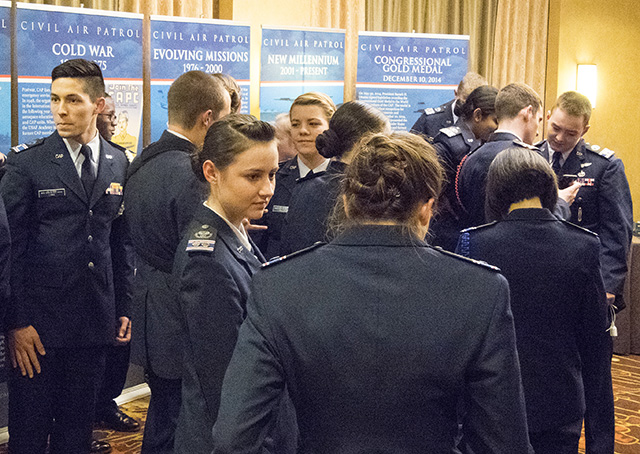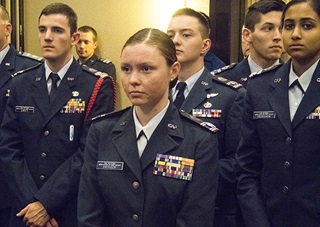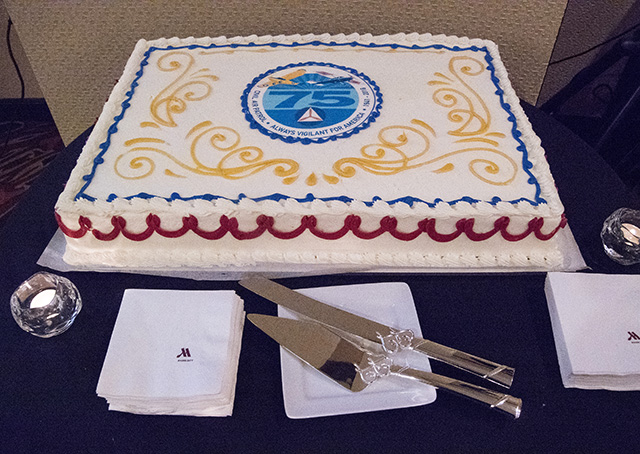
The Civil Air Patrol kicked off its seventy-fifth anniversary celebration by doing what it does best—working behind the scenes to support scores of mentors and cadets keeping a fleet of 550 aircraft in the sky for its 56,000 volunteers.
The Feb. 25 anniversary kickoff reception at a hotel in Crystal City, Virginia, saw about 200 Civil Air Patrol leaders and volunteers packed into a room as speeches and accolades were delivered. Patrol members in dress blue uniforms, with insignias and awards displayed across their chests, punctuated the scene.
Participants nibbled on pieces of a three-foot-long cake decorated with white icing, blue and gold trim, and a pair of high-flying observation airplanes to initiate the year-long gala. The continuing celebration will honor the Civil Air Patrol’s evolving roles since its inception on Dec. 1, 1941, just before the United States became involved in World War II. President Harry S. Truman signed a measure incorporating the unit in 1946, and that’s when the organization officially became the civilian auxiliary of the U.S. Air Force.
Since then, the unit has helped conduct countless searches, rescues, and training missions while building up an enthusiasm for flight and an understanding of aviation for its volunteer male and female cadets.
In the early days, cadets (ages 15 to 18 and in their final two years of high school) were taught first aid, Morse code, military law, and proper signaling—which were extremely important skills during wartime. CAP education has evolved to include science, technology, engineering, and math (STEM) concepts, with a keen emphasis on piloting skills. Today’s cadets can become eligible to join at age 12 and serve as cadets until they are 21.
The organization’s national commander, Maj. Gen. Joe Vazquez, said the patrol accepts both males and females into its ranks, and was one of the first military units to do so.
In 1947 the patrol worked closely with the U.S. Army Air Forces to recruit 17-year-old men into the highly successful Air Corps Enlisted reserve, and those cadets would be called to duty after reaching 18. “Female cadets, in turn, were recruited into the Women’s Army Corps,” reads the organization’s historical archive.
Vazquez said that although the patrol’s mission has indeed evolved over the years, it has never strayed far from its roots.
“We’ve got the largest number of Cessnas in the world in any one organization that controls a fleet [of airplanes], and we have it on purpose. We use the skills of our volunteer pilots and volunteer air crews to serve America with disaster relief flying, search and rescue, and other assistance missions to our Air Force partners, and various relief agencies,” Vazquez said.

He said the cadet program is one of the Civil Air Patrol’s mainstays: “The cadets are styled in a similar fashion to Junior ROTCs, but the difference is our cadets volunteer to be CAP members—it’s not (offered) in the schools. They have to seek us out so we have highly motivated youth.”
Cadets typically meet at airports after school one evening per week to delve into aviation concepts. On weekends they participate in flying during search and training missions.
Vazquez counts the total immersion into an aviation environment as one of the main benefits cadets receive from their participation. “Each cadet gets orientation rides and we have a school each year where most of the cadets successfully solo a Cessna.”
As the organization looks to its future, it has big plans patterned on the country’s northern neighbor.
“We have a sister cadet organization called Air Cadet Link in Canada,” Vazquez said. “They put 400 of their cadets per year through private pilot flight training and that’s what we want to try to do. We’re working on that for the future and we’re going to roll it out in 2017.”
Vazquez said he wants to eventually put 500 pilots a year through private pilot flight training to address the pilot shortage in the United States.
He said in recent years the organization has introduced STEM concepts to students in grades K through 12 that reach about 150,000 of the country’s youth each year. “The whole purpose behind our STEM kits it is to bring them up to speed with science, education, and aviation.”
While many things have changed since the Civil Air Patrol began its mission 75 years ago, some concepts remain constant, he said.
Vazquez said education was—and still is—one of the original missions of the Civil Air Patrol, “but it wasn’t called aerospace education back then, it was called aero-mindedness.”
The whole point, he said, was to make sure the American population was more educated about aviation and the future of aviation, and now that has extended into aerospace.
“We’ve continued that tradition for 75 years and we’re going to continue to do that into the future,” Vazquez said.




